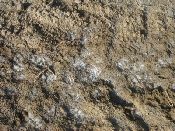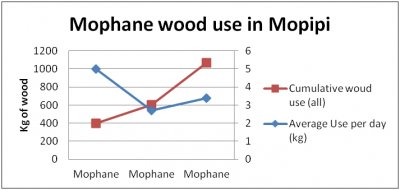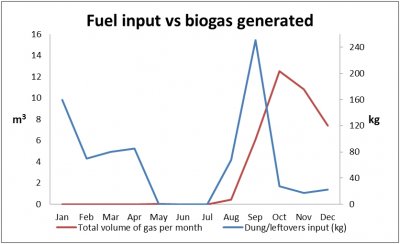|
The Boteti study area has overgrazing as the degradation challenge. The extent of overgrazing in pastures, woodland and settlements is fragile to critical. Firewood collection adds to the range degradation, thus alternative energy in the form of biogas has been proposed by the stakeholders. Firewood is the main source of energy, not only in common households but also in schools and communal centers.
Since cattle is one of the main sources of income, biogass might be a valuable alternative. The generated gas is expected to reduce heavy firewood use and even promote socio-economic activities which will reduce poverty – perceived to be one of the main drivers of land degradation other than droughts.
Experiment: biogas to conserve bushland
|
At the very bottom is a digester, in which the cow dung is fed. The fermentation yields gas, which collects in the tank above. Pipes are used, to collect the gas for various uses e.g. cooking, heating and lighting. The amount of cow dung input, is measured, against the volume of gas generated. A biogas tank has a movable cover that adjusts to the amount of gas produced. Different design exist, and this design with the above gorund feeder pipe was maybe not the most easy. Alternatives are buried gas tank with a cover level to the surface and a feeder canal where water and dung are mixed are also at surface level. In any case biogas is relatively new in Botswana with only a few examples existing in the country.
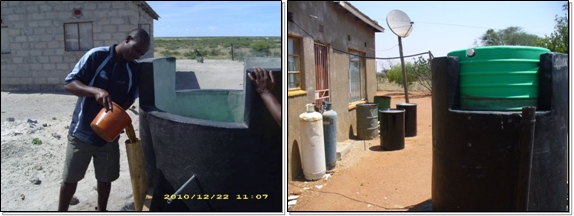
In the experiment the amount of fue lwood gathered by the village was monitored, and its use compared to the use of biogas (in cooking and heating activities of the household connected to the tank). There is sufficient cow dong present to use biogas on a larger scale.
The cumulative increase in firewood demand is apparent in households (see figure below). The same pattern applies for the local schools, where firewood demand is creating local conflicts over the resource. The Department of Forestry and Range Resources has conducted studies in the area, in response to the firewood and general degradation concerns.
Cow dung may be collected at water points, kraals and cattle posts. The distances to these vary, hence the costs. Within walking distance 10-50kg may be collected e.g. in a wheel barrow; but further away, donkey carts and vehicles may be used, which take on more cow dung quantities e.g. 250-450kg per load. However, as the experiment proceeded, food leftovers were introduced as the fuel. The response of the biogas was more immediate. The locals then introduced food leftovers from the secondary school to fuel the biogas. This has remained a very successful intervention – the results being very positive for August to December, 2011 (see below). NB: 1kg cow dung produces 0.06m³ gas, which can feed a family of 4-6 (at 3 meals per day) for about 4 days.
Challenges
- Lack of transport to collect dung/leftovers from the secondary school which has offered to provide the leftovers. The school is about 3km away.
- Transport of bio waste when from far becomes a bottleneck quickly
- When schools are closed (limited leftovers) thus the biogas fuel (leftovers) are scarce. The biogas tank rises minimally, as a result.
- The loose/free movement within the digester of the biogas tank and its lightness (not heavy), reduces the much needed pressure to push the gas towards the stove. Thus cooking is rather slow when using the stove. The top can be weighted down.
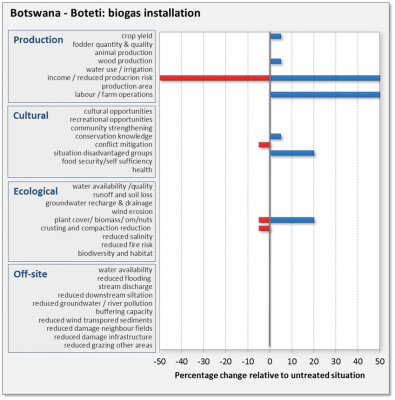 |
The results are evaluated from a production, socio-cultural and economic point of view. The bars express the estimated or measured percentage of change with respect to the reference situation. This change can be positive (blue) or negative (red). Note that this evaluation is based on the experiments, on the long term experience of the coordinating team in this area and on consultations with the farmers. |
| The impact of the biogas is too early to show, but schools, villagers – have all expressed interest, citing the limited energy sources as a major challenge. Interest ranged from using the gas for: cooking, powering a generator to produce electricity, to larger scale like providing energy for cooking i.e. to replace 19 truckloads that are needed every 3 weeks for each secondary school in the area. |
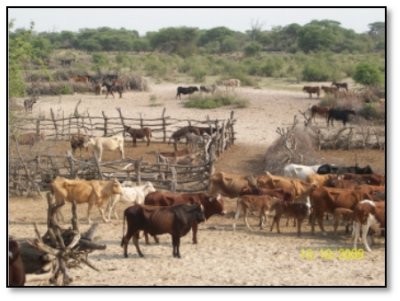 |
|
The biogas is running well, and the results are beginning to show i.e. how much gas is generated from what quantity of cow dung or food waste. This will be the first time in Botswana, where exact performance measurements are done.
|
|
The impact of the biogas, is too early to show, but schools, villagers – have all expressed interest, citing the limited energy sources as a major challenge. Interest ranged from using the gas for: cooking, powering a generator to produce electricity, to larger scale like providing energy for cooking i.e. to replace 19 truckloads that are needed every 3 weeks for each secondary school in the area. However, the uptake of the biogas technology in the country is quite an expensive enterprise. Limited trained personnel and service providers, remain key challenges. For the poor households, the starting capital of around €600 is too steep. This is despite biogas being a feasible energy source in other countries. The few commercially run biogas plants in Botswana e.g. Cumberland Hotel (uses kitchen leftovers) and the Richmark (uses chicken waste) have shown high success, with high capital returns. The plants are economic viable, and lead to alternative energy sources, away from coal generated electricity.
|
|

